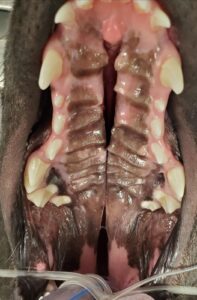
04 Apr Congenital Cleft Palates and Lips in Puppies and Kittens
It is truly one of the most miraculous events when a puppy or kitten is born. To think that what started as a couple of cells could turn into a perfect furry little creature, able to squirm and nurse and make noises can seem magical. But the formation of a puppy or kitten does not always proceed normally. There are many types of birth defects that can occur, and we don’t always know the cause. One type of defect that a board-certified veterinary dentist™ can fix is a cleft palate and/or lip. This type of birth defect is more common in puppies than kittens and is often hereditary.
How to Know If Your Pet Has a Cleft Palate
A cleft lip like the one in this picture, is easy to see in a small puppy.

A cleft palate (the roof of the mouth) is not as obvious when a puppy is first born. Affected puppies can have difficulty nursing and will have difficulty gaining weight. Milk may come out of the nose and the puppy may get pneumonia from accidentally inhaling milk. These puppies may not be able to nurse safely, but an experienced puppy raiser can feed the puppy using a tube passed into the esophagus. It is also possible to have a custom-made device called an obturator, that blocks the defect in the roof of the mouth while the puppy is fed from a bottle. Puppies are transitioned to solid food as soon as possible to decrease the chance of getting pneumonia.
Congenital (meaning the puppy is born that way) clefts can affect the nose, lips, front teeth, roof of the mouth and even all the way back to the soft palate. Some puppies have all areas affected while others may only have one type of cleft. Defects that affect only the soft palate can be more difficult to diagnose. This area is so far back in the mouth that it can be difficult to visualize during a routine exam. Puppies with soft palate defects may gag and snort when eating or drinking. Sometimes they have nasal discharge. This image shows a cleft of the hard and soft palates in an adult dog.

How Are Cleft Palates Treated?
Surgery to correct palatal defects should only be performed by an experienced oral surgeon. If a surgery is not done correctly the first time, it can make future surgery less likely to succeed. While the defect in the palate may not appear to be very wide, the defect in the underlying bone is often much larger. It is important to have 3D imaging such as cone beam CT done before surgery to make the correct choice for the type of surgical repair performed.
The ideal age to perform cleft palate repair is usually 3-4 months of age. The goal is to eliminate any symptoms such as chronic nasal infections. A cleft lip by itself does not affect the function of the mouth and nose, but it can be repaired if the owner chooses to do so. Recovery from cleft palate surgery can be challenging because the puppy needs to rest as much as possible and not chew on any toys.
Board-Certified Veterinary Dentist™ in Fort Collins
At Animal Dental Care & Oral Surgery in Fort Collins, our board-certified veterinary dentist™ has years of experience correcting palatal defects. If you have a puppy or kitten that is affected, please give us a call!
Images used under creative commons license – commercial use (4/4/2024). Photo by Elena Mozhvilo on Unsplash



